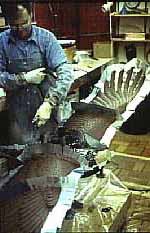 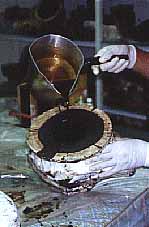 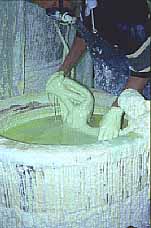
LOST WAX
BRONZE PROCESS
by William H.
Turner
This method of casting bronze
is an ancient craft, at least 5,000 years old. It remains essentially unchanged, but has
been improved with modern technology. We believe we have made some improvements.
The first step in the
creation of a bronze sculpture is a mental concept nourished and inspired by observation.
If this is a large or complex bronze we usually design a maquette (a miniature scale
model) of the proposed larger one. This gives one a good idea what the finished bronze
will look like before the actual model is begun, allowing for manipulation and
experimentation on a small and convenient scale.
The next step is the
creation of a model in clay or wax that will be exactly like the proposed sculpture. In
doing this, one must anticipate mold making, welding joints, etc. so that future steps are
as easy as possible.
-
Next a rubber and/or plaster
mold is made of every part of the sculpture. Sometimes there is one piece, sometimes many.
After the mold is made the clay or wax model is of no further use and is usually recycled.
Clay that is a frog today may be an elephant tomorrow.
 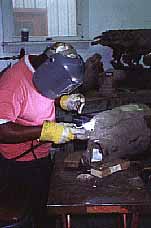 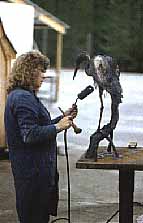
Into the mold, hot wax is
brushed and poured to form a hollow wax pattern identical to the original model. For every
bronze that will be made there must be a wax pattern. After wax gates, vents, and channels
are attached to the wax pattern, it is ready to be invested. This means a mold of a
refractory material will be built around and into the hollow wax pattern.
This investment process is
accomplished by alternately dipping the wax into a liquid silica and then powdered silica,
allowing each coat to dry for several hours. After about a week the mold is built up to
the thickness needed to hold molten bronze. This wax pattern, encased in a silica mold, is
then placed in a 1500 degree F oven and the wax is melted out, leaving a hollow silica
mold ready to receive the molten bronze.
The mold is allowed to cool
and, after inspection for cracks, is inverted (with the opening pointed up) in the same
oven and reheated. At the same time, bronze ingots are melted (2000 degrees F) and the
molten bronze is poured into the hot silica mold.
After cooling, the mold is
removed with hammers and a sandblaster. The bronze sprues and vents are removed and the
casting remains. If more than one piece is involved in the sculpture, the parts are welded
together and the resulting seams removed with careful grinding and sanding.
After a final sandblasting
or glass beading, the bronze is ready for the final finish, a patina. Patinas are created
by applying liquid chemicals to the surface of the bronze after it is heated with a blow
torch. Under heat these chemicals react with the copper content of the bronze alloy to
give a controlled oxidation. Colors can vary according to the intensity of the heat and
the chemicals used. Usually many coats are applied until the desired color is obtained.
This final step is the
application of several coats of wax or sealer to enrich the color and protect the bronze.
|






